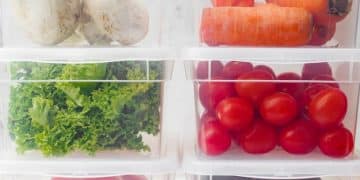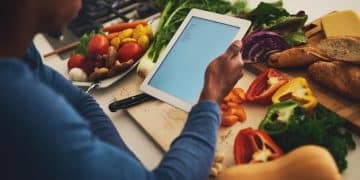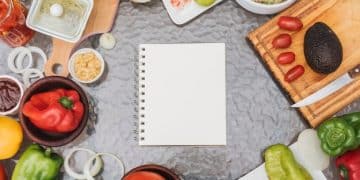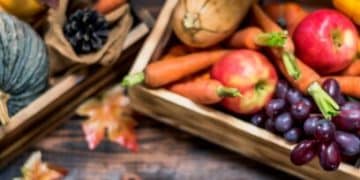Reduce Food Waste, Reduce Spending: Extend Grocery Life & Save Money
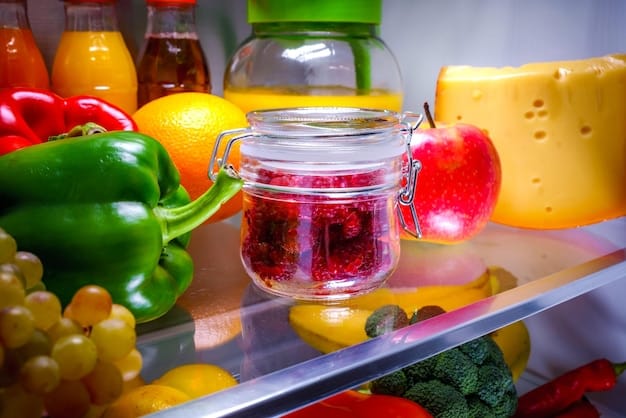
Reducing food waste significantly lowers household spending by extending the shelf life of groceries through strategic shopping, proper storage, creative meal planning, and inventive use of leftovers, thereby maximizing your food budget and minimizing disposals.
In a world where every penny counts, mastering the art of making groceries last longer isn’t just about kitchen efficiency; it’s a powerful strategy to reduce food waste, reduce spending: practical tips for extending the life of your groceries. This approach transforms discarded food into saved dollars, making a tangible difference in your household budget and contributing to a more sustainable lifestyle. Embrace these practical tips to unlock significant savings and minimize your environmental footprint.
The Hidden Costs of Food Waste and Why it Matters
Food waste is not just an inconvenience; it represents a significant drain on household finances and a substantial environmental burden. Globally, an estimated one-third of all food produced for human consumption is lost or wasted, amounting to about 1.3 billion tons per year. For an average American family, this translates into hundreds, if not thousands, of dollars literally being thrown into the trash annually.
Understanding the full scope of food waste goes beyond just the money spent on uneaten items. It encompasses the energy and resources used to produce, transport, and sell that food—resources that are then squandered when the food reaches the landfill. Decomposing organic matter in landfills generates methane, a potent greenhouse gas, further exacerbating environmental concerns. By acknowledging these hidden costs, we gain a stronger motivation to adopt practices that minimize waste.
The Economic Impact on Households
From an economic perspective, food waste directly impacts your budget. Think about the perfectly good produce that wilts before you can eat it, the half-eaten leftovers that get forgotten, or the bulk purchase that spoils because it wasn’t stored correctly. Each of these instances represents money taken directly from your pocket. Reducing this waste means those dollars can be reallocated to other essential expenses, savings, or even discretionary spending.
- Identify common waste culprits: bread, dairy, fresh produce, and cooked leftovers are frequently discarded.
- Track your current waste: keep a simple log for a week to pinpoint what you’re throwing away most often.
- Calculate potential savings: estimate how much money you could save by preventing that waste.
The cumulative effect of small changes can be staggering. Shifting your mindset from convenience to conscious consumption can unlock significant financial gains over time. It’s about being a savvy consumer, making informed choices that benefit both your wallet and the planet.
Environmental Footprint of Food Loss
Beyond the financial implications, the environmental consequences of food waste are profound. The resources invested in food production—water, land, energy, fertilizers, and labor—are all wasted when food is discarded. For example, producing just one kilogram of beef requires thousands of liters of water. When that beef is thrown away, all that water and the associated energy are also wasted.
Furthermore, when food rots in landfills without access to oxygen, it produces methane, a greenhouse gas significantly more potent than carbon dioxide in trapping heat in the atmosphere over a 20-year period. Reducing food waste contributes directly to mitigating climate change, conserving natural resources, and lessening the burden on waste management systems. It’s a simple, yet impactful, way each household can contribute to global sustainability efforts.
Smart Shopping Strategies to Prevent Waste at the Source
The journey to reducing food waste often begins before you even step foot in the grocery store. Smart shopping strategies are the foundation, laying the groundwork for a pantry and refrigerator stocked with items you’ll actually use before they spoil. This proactive approach minimizes impulsive buys and ensures every item on your list serves a purpose, preventing many common waste scenarios.
Developing a thoughtful shopping routine can dramatically cut down on unnecessary purchases and, by extension, food waste. It’s about being deliberate and mindful, resisting the urge to buy more than you need or items that don’t fit into your immediate meal plans.

Plan Your Meals First
Meal planning is arguably the most effective tool in your waste-reduction arsenal. Before you write a single item on your shopping list, take some time to plan your meals for the coming week. Consider breakfast, lunch, dinner, and any snacks. Factor in your family’s schedule, ensuring you plan for meals that match the time you have available for cooking.
- Check your pantry: identify ingredients you already have and can incorporate into your planned meals.
- Build a list: based on your meal plan and existing inventory, create a precise grocery list.
- Stick to the list: resist the temptation of attractive offers or unplanned items at the store.
This structured approach ensures you only buy what is necessary, reducing the likelihood of perishable items expiring before they can be used. It also streamlines your cooking process, making weeknight dinners less stressful.
Shop with a Purpose, Not on Impulse
Impulse buying is a significant contributor to food waste. Those “buy one, get one free” deals on perishable items might seem like a bargain, but if you won’t use the second item before it spoils, it’s money wasted, not saved. Always evaluate whether you truly need an item and if you’ll consume it in time.
Before heading to the store, take stock of what you already have at home. This simple habit prevents duplicate purchases and ensures older items get used first. Also, consider the size of packages. While bulk buying can be economical for non-perishables, for fresh produce or dairy, smaller quantities might be more appropriate if you don’t use them quickly. Being conscious of packaging size relative to consumption speed is key to smart, waste-reducing shopping.
Mastering Storage Techniques for Maximum Freshness
Once groceries are brought home, their longevity largely depends on how they are stored. Proper storage can significantly extend the freshness of different food types, preventing premature spoilage and ensuring you get the most out of every purchase. This involves understanding the unique needs of various fruits, vegetables, dairy, and pantry staples.
Many common storage mistakes lead to food items going bad faster than they should. A little knowledge about optimal temperatures, humidity levels, and common storage pitfalls can make a big difference in reducing your food waste and maximizing the life of your groceries.
Refrigerator Organization and Temperature Control
Your refrigerator is a complex environment, and how you organize it impacts food preservation. Different areas of the fridge have varying temperatures, with the bottom shelves typically being the coldest. Meats and poultry should always be stored on the lowest shelves to prevent drips from contaminating other foods.
- Produce drawers: use these for fruits and vegetables, separating ethylene-producing fruits (like apples and bananas) from ethylene-sensitive vegetables (like broccoli and lettuce).
- Upper shelves: ideal for leftovers, cooked foods, and ready-to-eat items.
- Door shelves: the warmest part of the fridge, suitable for condiments, juices, and butter, but not milk or eggs.
Maintain your refrigerator temperature at or below 40°F (4°C) and your freezer at 0°F (-18°C) to inhibit bacterial growth. Regularly clean and declutter your fridge to ensure good airflow and visibility of all items, preventing forgotten foods from spoiling.
Pantry and Countertop Storage Best Practices
Not all foods belong in the fridge. Many fruits and vegetables, as well as pantry items, thrive at room temperature or in cool, dark places. Understanding these distinctions is crucial for extending their shelf life.
Potatoes, onions, and garlic should be stored in a cool, dark, and dry place, away from light and excessive moisture to prevent sprouting and rotting. Ripe avocados, tomatoes, and bananas can be kept on the countertop until they reach desired ripeness, then moved to the fridge if you wish to slow further ripening. Breads and baked goods can be stored at room temperature in airtight containers or frozen for longer preservation. Dry goods like pasta, rice, and flour should be kept in airtight containers in a cool, dark pantry to protect against pests and moisture, ensuring they remain fresh for extended periods.
Creative Culinary Uses for “Almost Expired” Foods
Even with careful planning and storage, some foods might approach their expiration date or show signs of losing their peak freshness. This doesn’t mean they’re destined for the bin. With a bit of culinary creativity, these items can be transformed into delicious meals, snacks, or ingredients, preventing waste and adding versatility to your cooking.
The key is to think of these items not as waste, but as opportunities for new flavors and textures. Embracing this mindset can lead to exciting discoveries in your kitchen and significant reductions in your grocery budget.
Browning Fruits and Wilting Vegetables
Fruits that are overly ripe or vegetables that have started to wilt are often discarded, but they still have plenty of life left. Browning bananas are perfect for banana bread, muffins, or smoothies. Soft berries can be cooked down into sauces, jams, or added to oatmeal and yogurt. Mushy apples are excellent for applesauce or apple pie filling.
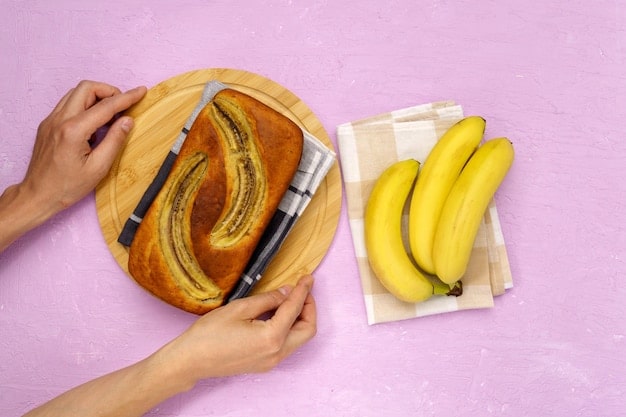
Wilting vegetables, such as carrots, celery, or leafy greens, can be revitalized by soaking them in ice water for a short period. If they are too far gone for salads, they are ideal for soups, stews, broths, stir-fries, or roasting. Even vegetable scraps like onion peels, carrot tops, and herb stems can be saved in the freezer to make flavorful homemade vegetable broth.
Transforming Leftovers and Scraps
Leftovers are a common source of food waste. Instead of letting them languish, think about how they can be repurposed. Leftover roasted chicken can become chicken salad, quesadillas, or part of a hearty soup. Cooked rice can be transformed into fried rice or a base for a grain bowl. Day-old bread can be made into croutons, breadcrumbs, or French toast.
- Reinvent last night’s dinner: turn cooked pasta into a pasta bake or cold salad; meat into tacos or sandwiches.
- Use vegetable scraps: collect them for homemade stock, or even ferment some for pickling.
- Compost what you can’t use: for truly inedible scraps, composting returns nutrients to the soil.
The principle here is to view food not as single-use items but as versatile components that can contribute to multiple meals. This approach not only reduces waste but also encourages experimentation and innovation in your cooking.
Understanding Food Labels: “Best By,” “Sell By,” and “Use By”
One of the most confusing aspects of food waste prevention is deciphering food labels. “Best by,” “sell by,” and “use by” dates are often misunderstood, leading consumers to prematurely discard perfectly safe and edible food. Understanding the true meaning behind these labels is crucial for reducing unnecessary waste and saving money.
These dates are primarily indicators of quality, not safety, with the exception of “use by” on highly perishable items. Armed with accurate information, you can make more informed decisions about when to consume or discard food, ensuring you don’t throw away good food prematurely.
Decoding Common Date Labels
The U.S. Food and Drug Administration (FDA) and the U.S. Department of Agriculture (USDA) provide guidance on these labels, but standardization can still vary. Consumers often equate these dates with food safety, which is largely incorrect for most products.
- Best By/Best If Used By: This date indicates when a product will be at its best flavor or quality. It is not a purchase or safety date. Food can typically be consumed safely past this date if stored properly.
- Sell By: This date helps stores manage inventory. It tells the store how long the product should be displayed for sale. Consumers should buy the product before this date, but it can be consumed safely for some time thereafter.
- Use By: This is the only date label that directly relates to food safety. It is typically found on highly perishable items like deli meats, raw chicken, or pre-packaged salads, and indicates the last day the product is recommended for use while at peak quality. After this date, quality and safety may decline.
For most foods, your senses—smell, sight, and touch—are reliable indicators of spoilage, often more accurate than a printed date. If a food product smells off, has visible mold, or changes in texture, it’s best to discard it regardless of the date.
Beyond the Label: Trusting Your Senses
While “use by” dates on highly perishable foods should be taken seriously, for many other products, relying solely on package dates can lead to significant waste. Many pantry items, frozen foods, and even some dairy products remain perfectly edible long past their “best by” or “sell by” dates.
For example, canned goods, dried pasta, and cereals can often be consumed months or even years beyond their printed dates if stored in a cool, dry place. Hard cheeses might develop a little mold on the surface, which can often be cut off safely, while the rest of the cheese remains good. Eggs, if stored correctly in the refrigerator, can often be safe to eat for several weeks past their “sell by” date; a simple float test can confirm their freshness. Cultivating an understanding of these nuances empowers you to make informed decisions and prevent unnecessary food waste.
Leveraging Freezing and Canning for Long-Term Preservation
When you find yourself with an abundance of fresh produce or cooked meals that you won’t consume immediately, freezing and canning emerge as invaluable tools for long-term preservation. These methods allow you to extend the life of your groceries significantly, locking in freshness and nutrients for months, or even years, down the line, thereby drastically reducing waste and maximizing your budget.
Understanding the proper techniques for both freezing and canning can transform your kitchen into a food preservation powerhouse, enabling you to take advantage of seasonal sales or garden bounties without worrying about spoilage.
Freezing: A Versatile Preservation Method
Freezing is arguably the easiest and most accessible method of food preservation for most households. It effectively halts bacterial growth and enzyme activity, keeping food safe and relatively fresh for extended periods. Almost anything can be frozen, from fruits and vegetables to cooked meals, bread, and even dairy products like milk or cheese.
- Portion and label: freeze food in meal-sized portions and label clearly with contents and date of freezing.
- Blanch vegetables: briefly boil most vegetables before freezing to preserve color, flavor, and nutrients.
- Airtight packaging: use freezer-safe bags or containers to prevent freezer burn.
Think about freezing ripe berries for smoothies, blanching and freezing vegetables for future stir-fries, or portioning out leftover stews and soups for quick meals. This proactive approach ensures that seasonal gluts or bulk purchases don’t go to waste, providing convenient and budget-friendly meals down the line.
Canning and Pickling: Traditional Preservation at Home
For those interested in a more traditional approach, canning and pickling offer robust long-term storage solutions. Canning involves processing food in sterile jars to create a vacuum seal, preventing spoilage. Pickling uses an acidic solution, typically vinegar, to preserve foods, often creating unique flavors in the process.
While canning requires a bit more equipment and attention to safety protocols (especially for low-acid foods), it’s excellent for preserving fruits, vegetables, and even meats for shelf-stable storage. Pickling is simpler and perfect for cucumbers, onions, or even green beans, adding a tangy twist to your meals. These methods are particularly useful for garden harvests or when you find produce at farmers’ markets. While requiring an initial investment of time and supplies, the long-term savings and satisfaction of homemade preserved goods are significant.
Meal Prep and Mindful Eating to Finish What You Start
Even with smart shopping and proper storage, food waste can still occur if meals aren’t utilized efficiently. This is where meal preparation and mindful eating practices come into play. By actively managing how food is cooked and consumed, you ensure that the effort put into purchasing and preserving groceries culminates in actually eating them, drastically reducing plate waste and forgotten leftovers.
These practices focus on the tail end of the food journey, ensuring that what makes it into your kitchen ultimately makes it into your stomach, closing the loop on responsible food consumption and maximizing your financial investment in groceries.
The Power of Meal Prep
Meal prepping is not just for fitness enthusiasts; it’s a powerful tool for waste reduction. By dedicating time, typically once a week, to prepare components of meals or entire dishes, you make healthy eating more accessible and reduce the likelihood of ordering takeout due to lack of time. This, in turn, minimizes food spoilage from unused ingredients.
- Prep individual ingredients: wash and chop vegetables, cook grains, or pre-cook proteins.
- Assemble full meals: prepare complete meals in containers for grab-and-go options.
- Plan for “flex meals”: account for one or two nights of using up odds and ends from the fridge.
Meal prep ensures you have ingredients ready for specific dishes or allows for quick assembly of diverse meals throughout the week. It helps to utilize fresh produce before it spoils and makes it easier to incorporate all the groceries you’ve bought into your diet.
Embracing Mindful Eating and Portion Control
Mindful eating extends to paying attention to how much food you serve and consume. Over-serving leads to plate waste, a significant source of discarded food in many households. Encourage portion control and listen to your body’s hunger cues.
Before throwing out leftovers from your plate, consider if they can be salvaged. Small amounts can sometimes be added to future meals as “mix-ins” or combined for a creative “leftover stew.” Understanding healthy portion sizes and serving just enough often means you’re more likely to finish your meal, leaving less on the plate to be discarded. This conscious consumption habit is an often-overlooked but crucial component of a comprehensive food waste reduction strategy, benefiting both your health and your wallet by ensuring every bite counts.
Tracking and Reducing Your Food Waste Footprint
To truly shrink your food waste, periodic self-assessment and practical adjustments are essential. Understanding precisely what types of food you are wasting and why can unlock targeted strategies for improvement. Without this insight, efforts might be generalized rather than focused on the most problematic areas in your household.
This systematic approach involves identifying patterns, setting small, achievable goals, and making incremental changes that cumulatively lead to significant waste reduction and corresponding savings. It transforms abstract ideas into actionable steps, creating a real impact on your spending and sustainability.
Conducting a Food Waste Audit
A simple yet powerful exercise is to conduct a week-long food waste audit. For seven days, keep a dedicated bin or bag where you collect all truly uneaten food scraps that would normally go into the trash or compost. At the end of the week, examine the contents.
- Categorize waste: note down types of food (e.g., fresh produce, cooked leftovers, dairy, bread).
- Identify reasons for waste: was it spoilage, too much cooked, forgotten items, or picky eaters?
- Pinpoint patterns: are you consistently throwing away the same items or encountering the same problems?
This audit provides concrete evidence of your waste habits, offering valuable insights that generic advice cannot. It helps you recognize your unique pain points and tailor your waste-reduction strategies accordingly, leading to more effective and sustainable changes in your kitchen.
Setting Achievable Goals and Sticking to Them
Based on your food waste audit, set one or two specific, measurable goals. For example, instead of “waste less food,” aim for “no more wilted lettuce” or “finish all leftovers by Friday.” Start small, as even minor changes can make a noticeable difference and build momentum for larger shifts.
Implement the tips discussed previously, such as rigorous meal planning for problematic items, improving storage for frequently spoiled produce, or consciously repurposing leftovers. Regularly review your progress and adjust your strategies as needed. Celebrating small victories, like a week with significantly less waste, reinforces positive behaviors. This continuous cycle of observation, action, and review ensures that your efforts to reduce food waste and save money are ongoing, effective, and ultimately help you achieve a more efficient and sustainable household budget.
| Key Area | Brief Description |
|---|---|
| 🛒 Smart Shopping | Plan meals, check pantry, stick to lists to avoid impulse buys and reduce initial waste. |
| 🌡️ Optimal Storage | Organize fridge, use proper temperatures, and store pantry items correctly for longevity. |
| ♻️ Creative Reuse | Transform browning fruits/wilting veggies into new dishes, soups, or smoothies. |
| 🗓️ Understand Labels | Differentiate “Best by,” “Sell by,” and “Use by” dates to prevent premature discarding. |
Frequently Asked Questions About Reducing Food Waste
▼
Food waste directly reduces your disposable income. Every food item you buy and later discard represents money that could have been saved, invested, or spent on other necessities. This “invisible” expense can accumulate to significant amounts annually, impacting your overall financial health without you even realizing it until you start tracking.
▼
Proper storage varies by produce type. Generally, keep fruits and vegetables separate, as some fruits emit ethylene gas that can spoil sensitive vegetables. Store leafy greens in airtight containers with a damp paper towel. Root vegetables prefer cool, dark places, and many ripe fruits are best refrigerated to slow spoilage after ripening.
▼
Yes, often. “Best By” dates indicate peak quality, not food safety. Many foods remain safe to eat well past this date, especially pantry staples like cereals, pasta, or canned goods. Always use your senses—smell, sight, and texture—to assess freshness after the “Best By” date passes, rather than discarding automatically.
▼
Transforming leftovers is key to reducing waste. Turn cooked meats into sandwiches, tacos, or part of a quick stir-fry. Repurpose cooked grains into fried rice or a base for grain bowls. Soups, stews, and casseroles are excellent vehicles for combining various leftover vegetables and proteins, creating new, delicious meals.
▼
Absolutely. Freezing is a highly effective method for long-term food preservation. It halts the growth of microorganisms and slows down enzymatic activity, retaining freshness and nutrients. You can freeze almost anything, from raw meats and vegetables (often blanched first) to cooked meals, bread, and even dairy products like milk or cheese.
Conclusion: A Sustainable Kitchen for a Stronger Budget
The journey to reducing food waste and maximizing your grocery budget is an ongoing one, but it’s remarkably rewarding. By thoughtfully planning meals, mastering wise shopping habits, implementing effective storage techniques, creatively repurposing ingredients, and understanding food labels, you empower yourself to make every dollar spent on food count. These practices not only lead to significant financial savings but also contribute to a more sustainable lifestyle, lessening your environmental impact one meal at a time. Embrace these changes, and you’ll find your kitchen becoming a testament to efficiency, ingenuity, and fiscal responsibility.
